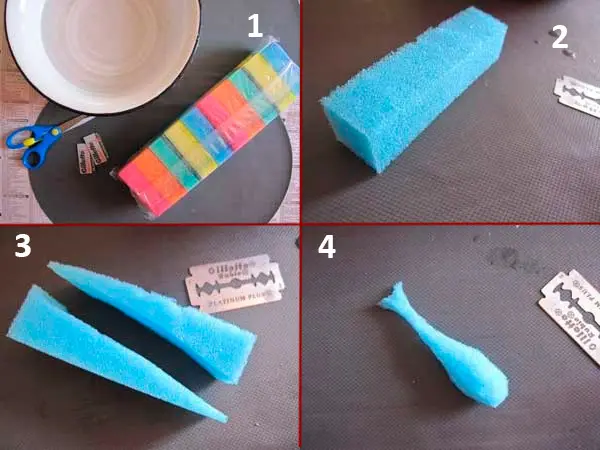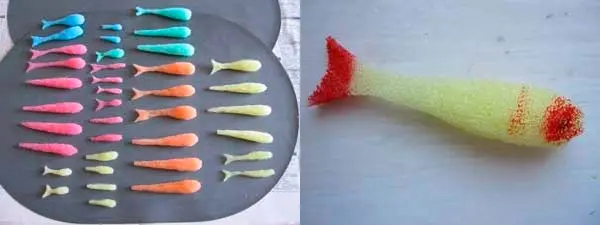
Foam lures – This is an invention of Soviet fishermen. In the West, in those days, they were already fishing with silicone baits, and in the USSR they knew about such baits by hearsay. Having shown ingenuity, Soviet fishermen used the widespread foam rubber to make soft lures. Despite the simplicity and primitiveness, foam rubber fish to this day remain in service with anglers.
A foam rubber fish, with uniform wiring, is not able to play like silicone, but with stepped or torn wires, it will not yield to silicone in any way. In addition, foam baits have a number of advantages:
- You can make excellent non-hooks from foam rubber.
- Foam rubber is easily impregnated with attractants.
- Foam rubber with an eared sinker is the most long-range.
- Such bait costs practically nothing.
From cheap, multi-colored foam rubber sponges, you can make a large number of catchy baits. Just about this will be discussed below.
For self-production of foam rubber fish, you can use household sets of multi-colored foam rubber sponges (photo 1). The fact that there are several colors is very good. Before you start working with foam rubber, it must be moistened with water and squeezed out. This will remove the static charge from the sponges, and the pieces of foam rubber will not stick to the scissors.

From the sponge, using a conventional blade, you need to cut off a rectangular blank of the required size (photo 2). Then, the cut blank is cut lengthwise, into two parts, diagonally with the same blade (photo 3). From this it follows that to make a foam rubber fish you need to have: a foam rubber sponge, an ordinary blade, ordinary scissors and not a lot of patience.
If you practice, then as a result it will be possible to get neat foam rubber fish, both with tails and without them. A fish without a tail is called a “carrot” by fishermen. At the same time, you can cut fish of any size, from 2 to 15 cm, but most often you can see foam baits up to 8 cm.
Lures are painted with an ordinary waterproof marker, but since multi-colored blanks are used, it is enough to finish the eyes or make several colored stripes on the body of the fish. In the photo, you can see how foam rubber fish can be painted and what appearance they can have.

Foam fish are mounted on single offset hooks (photo). Using such hooks, the result is excellent non-hooks that can catch the most twisted places. Of course, no one is safe from hooks, but they will be much less common.
They can also be equipped with tees, but this will already be a common bait, which is best used in clear water.
In order for the bait to be able to demonstrate everything that it is capable of, it is better to mount it on a flexible hitch using a sinker section (photo). In this regard, it is not recommended to use ordinary jig heads for their installation.

foam fish – this is a unique bait with which you can catch the most difficult places where ordinary silicone can not cope at all. You can catch any predator on foam rubber, such as pike, perch, pike perch, etc. Most of all, perch loves such baits, when guiding in the water column at medium depths. Considering the fact that the foam rubber fish is much softer than the silicone one, gatherings are very rare.
In his arsenal, the angler should have several of these lures of various lengths and colors. As mentioned above, foam rubber baits work best in the form of non-hooks, and with a flexible connection of a fish with a Cheburashka sinker.
5 types of do-it-yourself foam rubber fish.









